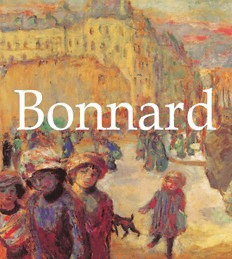
Bonnard PDF
Preview Bonnard
Bonnard Page 4: La Promenade, c. 1900. Oil on canvas, 38 x 31 cm, Private collection. Designed by: Baseline Co Ltd 19-25 Nguyen Hue Bitexco Building, 11th floor District 1, Hô Chi Minh-City Vietnam © Sirrocco, London, UK (English version) © Confidential Concepts, worldwide, USA © Bonnard Estate / Artists Rights Society, New York, USA / ADAGP, Paris All rights reserved No part of this publication may be reproduced or adapted without the permission of the copyright holder, throughout the world. Unless otherwise specified, copyrights on the works reproduced lies with the respective photographers. Despite intensive research, it has not always been possible to establish copyright ownership. Where this is the case we would appreciate notification ISBN : 978-1-78042-094-3 2 “I agree with you that the painter’s only solid ground is the palette and colors, but as soon as the colors achieve an illusion, they are no longer judged and the stupidities begin.” — Bonnard to Matisse, 1935 3 Biography 1867: Pierre Bonnard is born at Fontenay-aux-Roses near Paris. 1875: Enters the secondary school at Vanves, later attends the Lycées Louis-le-Grand and Charlemagne. Spends his summers at Grand-Lemps in the Dauphiné. 1886: Enters the Law Faculty of Paris University. 1887: Begins to study painting at the Académie Julian where he meets Paul Sérusier, Maurice Denis, Paul Ranson and Ibels. 1888: Leaves the University and enters the Ecole des Beaux-Arts. 1890: The exhibition of Japanese prints arranged at the Ecole des Beaux-Arts makes a deep impression on Bonnard. 1891: Shares a workshop with Vuillard and Denis in the Rue Pigalle. Though Denis becomes acquainted with Lugné-Poë, André Antoine and Paul Fort; works for the theatre. Enjoys his first success with the poster France-Champagne. Exhibits at the Salon des Indépendants and at the Gallery Le Barc de Boutteville. 1892: Turns to lithography. Is noted by such well-known art critics as Albert Aurier, Gustave Geffroy and Roger-Marx. 1893: Becomes acquainted with Marthe (Maria Boursin). Produces lithographs for the Petites ScènesFamilières and the Petit Solfègeby Claude Terrasse. 1896: First one-man show at the Durand-Ruel Gallery. Together with Vuillard and Maillol accepts an invitation to take part in the exhibition “La Libre Esthétique” in Brussels. Illustrates the novel Marie by Peter Nansen, published in the RevueBlanche. 1899: Vollard publishes an album of Bonnard’s colour lithographs entitled Quelques aspects de la vie de Paris. Works on a large series of lithographs for Paul Verlaine’s book of poems Parallèlement. 5 6 1900: Exhibits together with the other Nabis at the Bernheim-Jeune Gallery. Works in Paris and its environs: Montval, l’Etang-la-Ville, Vernouillet and Médan. 1902: Produces 156 lithographs for Longus’s tale Daphnis and Chloë. Takes part in the Bernheim-Jeune exhibition. In the summer works in Colleville. 1904: Works at l’Etang-la-Ville and Varengeville. Illustrates Jules Renard’s Histoires naturelles. 1905: Produces a series of nudes and portraits. Visits Spain. 1906: Exhibits landscapes and interiors at the Vollard Gallery. One-man show at the Bernheim- Jeune Gallery. In the summer sails on Misia Edwards’s yacht to Belgium and Holland. 1908: Visits Italy, Algeria, Tunisia and Britain. Illustrates 628-E-8by Octave Mirbeau. 1909: Works in Médan. In June goes to Saint-Tropez to visit Manguin. 1910: Works in the south where he regularly sees Signac and Renoir. 1911: Paints the triptych Mediterranean and the panels Morning in Paris and Evening in Paris commissioned by Ivan Morozov. 1912: Buys “Ma Roulotte”, a small villa in Vernonnet, not farfrom Giverny. Often sees Claude Monet. 1913: Visits Hamburg together with Vuillard. 1916: Works on a series of large panels for the Bernheim-Jeune Gallery. In November goes on a trip to Winterthur. 1918: The Young Artists Society elects Bonnard and Renoir as honorary chairmen. 1919: Fosca and Werth publish the first books devoted to Bonnard. 1925: Buys a small house at Le Cannet. Officially marries Marthe. 1926: Travels to the United States to act as a member of the Carnegie Prize jury. 1936: Receives a Carnegie Prize for the second time (first award in 1923). 1939: Settles at Le Cannet. 1942: Marthe Bonnard dies. 1947: Pierre Bonnard dies at Le Cannet. 7 In October 1947, the Musée de l’Orangerie arranged a large posthumous exhibition of Bonnard’s work. Towards the close of the year, an article devoted to this exhibition appeared on the first page of the latest issue of the authoritative periodical Cahiers d’Art. The publisher, Christian Zervos, gave his short article the title “Pierre Bonnard, est-il un grand peintre?” (Is Pierre Bonnard a Great Artist?). In the opening paragraph Zervos remarked on the scope of the exhibition, since previously Bonnard’s work could be judged only from a small number of minor exhibitions. The Parade 1890 Oil on canvas, 23 x 31 cm Private collection, Paris 8 9 But, he went on, the exhibition had disappointed him: the achievements of this artist were not sufficient for a whole exhibition to be devoted to his work. “Let us not forget that the early years of Bonnard’s career were lit by the wonderful light of Impressionism. In some respects he was the last bearer of that aesthetic. But he was a weak bearer, devoid of great talent. That is hardly surprising. Weak- willed, and insufficiently original, he was unable to give a new impulse to Impressionism, Woman in the Garden 1891 Oil on paper mounted on canvas, 4 panels, 160 x 48 cm each Musée d’Orsay, Paris 10
